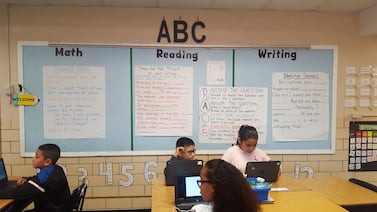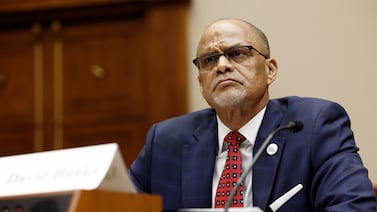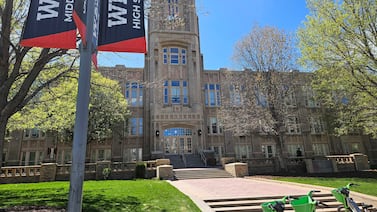Sign up for Chalkbeat Chicago’s free daily newsletter to keep up with the city’s public school system and statewide education policy.
Enrollment in Chicago Public Schools is flat for the first time in more than a decade, according to preliminary data obtained by Chalkbeat.
New preliminary numbers for this school year show just over 322,500 students are registered at CPS schools. The data represents enrollment as of the end of the day Monday, the 20th day of the school year, when the district traditionally takes its official count. On the 20th day of last school year, 322,106 students were enrolled according to official data.
CPS enrollment has been in decline for 12 years, so this year’s shift is significant.
In the past decade, the district’s student body shrunk by 20%, with the district seeing multiple year-over-year declines of roughly 10,000 students. The dramatic contraction began after the 2011-12 school year, which was the last year CPS saw a bump in enrollment, from 402,681 to 404,151 students. Last year, Chicago lost its standing as the nation’s third largest district.
Enrollment now appears to be leveling off in Chicago. In the past year, the city has welcomed thousands of migrant families from the southern border and in July, a top mayoral aide suggested that newcomers were boosting enrollment in schools.
A district spokesperson, however, said enrollment changes are due to multiple reasons and cautioned against attributing the shifts to “any one group of students.”
“We will offer more analysis and context to our enrollment figures later this month,” CPS CEO Pedro Martinez said in a statement. “We are honored and privileged to serve each and every student.”
It’s too early to tell if this is the start of a new trend, said Elaine Allensworth, who studies education policy and is Lewis-Sebring Director of the University of Chicago Consortium on School Research.
“If it’s just a one-time pause in the trends of declining enrollment, it might not have a big overall long-term effect, but it’s really just hard to say right now since we don’t know what will happen in the future,” Allensworth said.
Thinning enrollment was driven by factors such as dipping birth rates and other population changes. With the onset of the pandemic, districts across the country enrolled fewer students, with more than 33,000 students falling off Chicago’s rolls since the fall of 2020.
Shrinking schools have left CPS officials and mayors to contend with how to best fund classrooms, especially as student needs grew during the pandemic. Enrollment has long been a determining factor for how much state and federal money a district gets. Mayor Brandon Johnson has been an outspoken critic of tying enrollment to funding, but past mayors have funded schools within CPS based on how many kids they serve.
Even with fewer students, the district’s budget has grown to $9.4 billion. That’s roughly flat compared to last year’s budget, but up from a decade ago when it hovered around $6 billion. A new state funding formula and a wave of pandemic recovery money have helped offset enrollment declines. Though state money is increasing, the district has recently seen fewer dollars than expected due to lower enrollment and increased property wealth.
According to preliminary enrollment data analyzed by Chalkbeat, there are 5,767 more students learning English as a new language this school year than last year. That’s a sizable jump: CPS has historically enrolled an average of 3,000 new English learners annually, a district spokesperson said.
CPS officials said they do not track immigration status of students. They have pointed to the growth in English language learners as one sign of newcomers, but emphasized that not all English language learners are newcomers.
The district enrolls migrant students in three ways. First, like any student, migrant children can enroll directly at schools. They can also make an appointment at the city’s new welcome center housed inside Roberto Clemente Community Academy High School on the West Side.
Finally, enrollment teams are going to families’ homes, after receiving information from the city’s Department of Family and Support Services about those in need of help who can’t make it to the welcome center, said Karime Asaf, chief of the district’s Office of Language and Cultural Education.
Schools across the district have historically struggled to meet state regulations for providing proper support for English learners. When finding a school with the right program for English learners, officials try to stay within a two-mile radius of the child’s home, Asaf said.
Brighton Park Neighborhood Council, which provides extra support for kids and families at a handful of Southwest Side schools as part of the district’s sustainable community schools initiative, said they’ve noticed an increase in migrant families among the parents they serve who don’t have stable housing.
Last year, the organization placed a case manager part-time at a high school in Back of the Yards that needed extra help with parents as they enrolled more migrant students, said Sara Reschly, deputy director of the group’s community services division.
At Brighton Park Elementary School, case manager Lupe Fernandez said newcomer families currently have very basic needs, such as undergarments and help navigating the CTA. The school is planning to create a free “closet” where families can pick up things they need for free.
“If there are schools that have those strong community partnerships, you know, like that would be a place to start because then you can wrap services around the whole family,” Reschly said.
Asaf, with the district, said they are processing more school transfers among newcomers as those families find new homes or more permanent housing.
Preliminary data analyzed by Chalkbeat show this school year, nearly a quarter of Chicago Public Schools students are learning English as a new language — a figure that trumps other large districts. For example, 14% of students in New York City public schools, the nation’s largest district, were English learners last school year.
The preliminary data signals the continuation of another trend over the past decade: a decline in the share of students from low-income households. Preliminary data indicate that number is 67%, down from 73% last school year.
Reema Amin is a reporter covering Chicago Public Schools. Contact Reema at ramin@chalkbeat.org.







